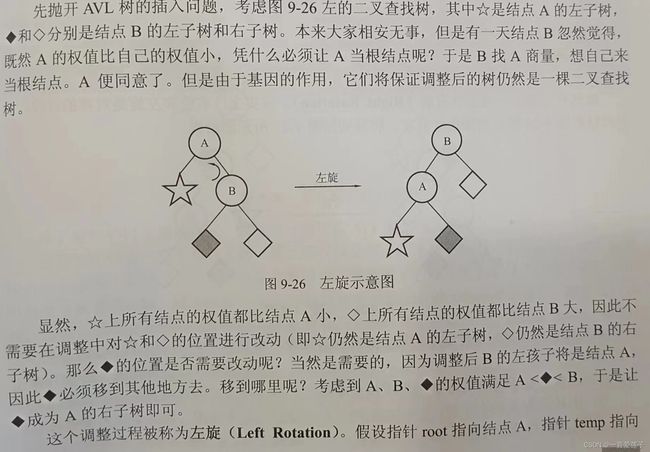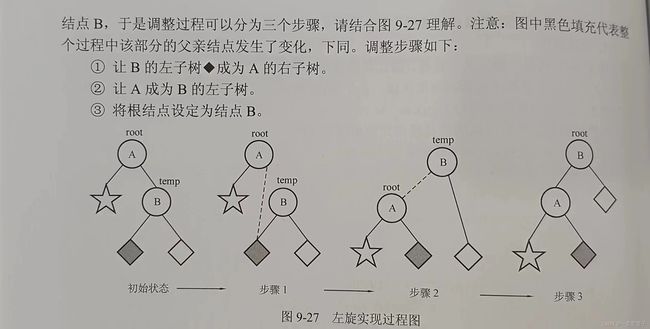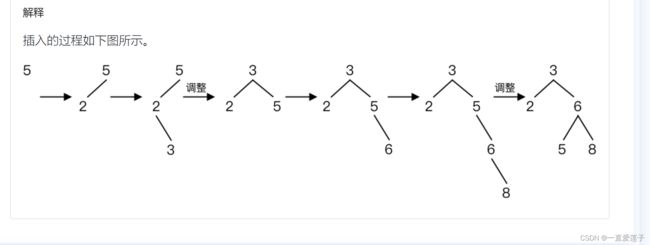算法笔记-第九章-平衡二叉树
算法笔记-第九章-平衡二叉树)
- 平衡二叉树
-
- 定义
- 大佬讲解
- 平衡二叉树的查找操作
- 插入操作
-
- 左旋操作
- 插入情况
- 插入操作代码
-
- 不考虑平衡操作
- 平衡插入操作
- 二叉查找树的平衡因子
- 平衡二叉树的判定
- 平衡二叉树的建立
平衡二叉树
定义
- 树还是一个二叉查找树
- 其左右树的高度之差的绝对值不超过1
左右高度之差称为该结点的平衡因子
大佬讲解
平衡二叉树的查找操作
本质上是和查找二叉树中的查找操作是一样的
void search(node* root, int x)
{
if (root == NULL)
{
printf("search failed\n");
return;
}
if (x == root->data) {
printf("%d\n", root->data);
}
else if (x < root->data)//如果x笔根节点的数据域小,说明x在左子树
{
search(root->lchild, x);
}
else
{
search(root->data, x);
}
}
插入操作
左旋操作
算法笔记-322页
void L(node* root)
{
node* temp = root->rchild;
root->rchild = temp->lchild;
temp->rchild = root;
//更新结点A的高度
updateHeight(root);
updateHeight(temp);
root = temp;
}
插入情况
AVL数的插入代码是在二叉查找树的插入代码上增加平衡操作的
插入操作代码
不考虑平衡操作
void insert(node*& root, itn v)
{
if (root == NULL)
{
root = newnode(v);
return;
}
if (v < root->v)
{
insert(root->lchild, v);//向左子树插入
}
else
{
insert(root->rchild, v);//向右子树插入
}
}
平衡插入操作
在这个基础上,由于需要从插入的节点开始从下往上判断结点是否失衡,因此需要在每一个insert函数之后更新当前子树的高度,并且在这之后判断树型是LL,LR,RR,RL型之一
插入权值为v的结点
void insert(node* root, int v)
{
if (root == NULL)
{
root = newnode(v);
return;
}
if (v < root->v)//v笔根节点的权值小
{
i = insert(root->lchild, v);//向左子树插入
updateHeight(root);
//更新树的高度
if (getBalancefactor(root) == 2)
{
if (getBalancefactor(root->lchild) == 1) {//LL型
R(root);
}
else if (fteBalancefactor(root->lchild == -1))
{
//LR型
L(root->lchild);
R(root);
}
}
}
else {
insert(root->rchild, v);//向右子树插入
updateHeight(root);//更新树高度
if (getBalancefactor(root) == 2)
{
if (gteBalancefactor(root->rchild) == -2) {
if (getBalancefactor(root->rchild) == -1) {
//RR型
L(root);
}
else if (getBalancefactor(root->rchild) == -1)//RL型
{
R(root->rchild);
L(root);
}
}
}
}
}
二叉查找树的平衡因子
#include <cstdio>
#include <vector>
#include <algorithm>
using namespace std;
const int MAXN = 50;
struct Node {
int data;
int height;
int l, r;
} nodes[MAXN];
int nodeCount = 0;
int newNode(int data) {
nodes[nodeCount].data = data;
nodes[nodeCount].height = 1;
nodes[nodeCount].l = nodes[nodeCount].r = -1;
return nodeCount++;
}
int getHeight(int root) {
if (root == -1) {
return 0;
} else {
return nodes[root].height;
}
}
void updateHeight(int root) {
nodes[root].height = max(getHeight(nodes[root].l), getHeight(nodes[root].r)) + 1;
}
int getBalanceFactor(int root) {
return getHeight(nodes[root].l) - getHeight(nodes[root].r);
}
int insert(int root, int data) {
if (root == -1) {
return newNode(data);
}
if (data < nodes[root].data) {
nodes[root].l = insert(nodes[root].l, data);
} else {
nodes[root].r = insert(nodes[root].r, data);
}
updateHeight(root);
return root;
}
vector<int> balanceFactor;
void inOrder(int root) {
if (root == -1) {
return;
}
inOrder(nodes[root].l);
balanceFactor.push_back(getBalanceFactor(root));
inOrder(nodes[root].r);
}
int main() {
int n, data, root = -1;
scanf("%d", &n);
for (int i = 0; i < n; i++) {
scanf("%d", &data);
root = insert(root, data);
}
inOrder(root);
for (int i = 0; i < (int)balanceFactor.size(); i++) {
printf("%d", balanceFactor[i]);
if (i < (int)balanceFactor.size() - 1) {
printf(" ");
}
}
return 0;
}
平衡二叉树的判定
#include <cstdio>
#include <vector>
#include <algorithm>
using namespace std;
const int MAXN = 50;
struct Node {
int data;
int height;
int l, r;
} nodes[MAXN];
int nodeCount = 0;
int newNode(int data) {
nodes[nodeCount].data = data;
nodes[nodeCount].height = 1;
nodes[nodeCount].l = nodes[nodeCount].r = -1;
return nodeCount++;
}
int getHeight(int root) {
if (root == -1) {
return 0;
} else {
return nodes[root].height;
}
}
void updateHeight(int root) {
nodes[root].height = max(getHeight(nodes[root].l), getHeight(nodes[root].r)) + 1;
}
int getBalanceFactor(int root) {
return getHeight(nodes[root].l) - getHeight(nodes[root].r);
}
int insert(int root, int data) {
if (root == -1) {
return newNode(data);
}
if (data < nodes[root].data) {
nodes[root].l = insert(nodes[root].l, data);
} else {
nodes[root].r = insert(nodes[root].r, data);
}
updateHeight(root);
return root;
}
bool isAVL(int root) {
if (root == -1) {
return true;
}
return isAVL(nodes[root].l) && isAVL(nodes[root].r) && abs(getBalanceFactor(root)) <= 1;
}
int main() {
int n, data, root = -1;
scanf("%d", &n);
for (int i = 0; i < n; i++) {
scanf("%d", &data);
root = insert(root, data);
}
printf(isAVL(root) ? "Yes" : "No");
return 0;
}
平衡二叉树的建立
#include <cstdio>
#include <vector>
#include <algorithm>
using namespace std;
const int MAXN = 50;
struct Node {
int data;
int height;
int l, r;
} nodes[MAXN];
int nodeCount = 0;
int newNode(int data) {
nodes[nodeCount].data = data;
nodes[nodeCount].height = 1;
nodes[nodeCount].l = nodes[nodeCount].r = -1;
return nodeCount++;
}
int getHeight(int root) {
if (root == -1) {
return 0;
} else {
return nodes[root].height;
}
}
void updateHeight(int root) {
nodes[root].height = max(getHeight(nodes[root].l), getHeight(nodes[root].r)) + 1;
}
int getBalanceFactor(int root) {
return getHeight(nodes[root].l) - getHeight(nodes[root].r);
}
int L(int root) {
int temp = nodes[root].r;
nodes[root].r = nodes[temp].l;
nodes[temp].l = root;
updateHeight(root);
updateHeight(temp);
return temp;
}
int R(int root) {
int temp = nodes[root].l;
nodes[root].l = nodes[temp].r;
nodes[temp].r = root;
updateHeight(root);
updateHeight(temp);
return temp;
}
int insert(int root, int data) {
if (root == -1) {
return newNode(data);
}
if (data < nodes[root].data) {
nodes[root].l = insert(nodes[root].l, data);
updateHeight(root);
if (getBalanceFactor(root) == 2) {
if (getBalanceFactor(nodes[root].l) == 1) {
root = R(root);
} else if (getBalanceFactor(nodes[root].l) == -1) {
nodes[root].l = L(nodes[root].l);
root = R(root);
}
}
} else {
nodes[root].r = insert(nodes[root].r, data);
updateHeight(root);
if (getBalanceFactor(root) == -2) {
if (getBalanceFactor(nodes[root].r) == -1) {
root = L(root);
} else if (getBalanceFactor(nodes[root].r) == 1) {
nodes[root].r = R(nodes[root].r);
root = L(root);
}
}
}
return root;
}
vector<int> pre;
void preOrder(int root) {
if (root == -1) {
return;
}
pre.push_back(nodes[root].data);
preOrder(nodes[root].l);
preOrder(nodes[root].r);
}
int main() {
int n, data, root = -1;
scanf("%d", &n);
for (int i = 0; i < n; i++) {
scanf("%d", &data);
root = insert(root, data);
}
preOrder(root);
for (int i = 0; i < (int)pre.size(); i++) {
printf("%d", pre[i]);
if (i < (int)pre.size() - 1) {
printf(" ");
}
}
return 0;
}









